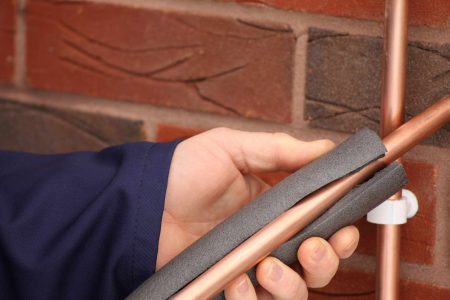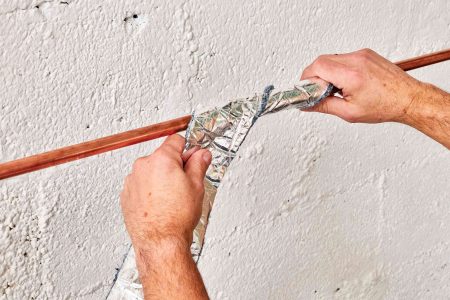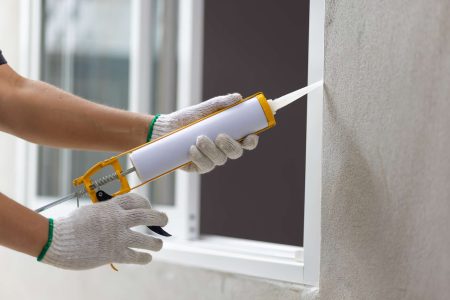Key Points
- Mice can enter homes through tiny cracks, chew vital lines, and spread disease.
- It’s important to seal cracks before winter, since sealants are harder to apply in cold weather.
- Experts recommend sealing gaps larger than 1/4-inch.
Mice pose a threat to your home’s safety. Mice will nest in walls, insulation, and basements, chewing wires and foam insulation. Because they seek warmth, rodents are one of the biggest winter threats to homes.
We spoke to entomologists and pest control experts to learn the cracks to seal before pests move in.
Meet the Expert
- Jim McHale is an entomologist & President at JP McHale Pest Management.
- Darren Backhouse is a Partner at MJ Backhouse Pest Control.
- Mariah Baggio-Deibler is an entomologist at PestMaster.
It’s important to seal cracks before winter. Pests are not seasonal and will continue to reproduce as long as they have a food source and shelter, says Jim McHale, President of JP McHale Pest Management.
However, many of these tasks are done outdoors. So, it’s easier to seal cracks when you’re not dealing with extreme cold. Additionally, many exterior sealants cannot be applied below a specific temperature limit (usually around 40 degrees F).
Want more home reno project tips and inspiration? Sign up for our free daily newsletter for the latest how-tos, reno guides, and more!
Don’t Miss
Doors and Windows
Be sure to seal around doors and windows. Use weatherstripping for minor gaps around doors or windows. Along with excluding mice from your home, weather stripping is beneficial because it keeps the cold out and the warmth in.
Besides weatherstripping, you can also use silicone or elastomeric caulk for minor gaps, recommends Mariah Baggio-Deibler, an entomologist at PestMaster.
“However, do not use foam as exclusion material since rodents can still chew through it, and it can be a bacterial growth media, posing a risk for indoor residents’ health,” she warns.
Foundation
Cracks in the home’s foundation give mice the easiest access to a home. Foundations are made of concrete, so it’s not unusual for foundations to develop cracks over time.
Be sure to seal all foundation openings to keep mice out. Do not use foundation sealer, a liquid product applied to the inside of foundations to limit moisture. Instead, use concrete and masonry caulk, which comes in a tube that fits into a caulking gun.
Roof Vents
Ground-level openings provide mice with easy access to a home. Yet they can also enter a home through higher areas. Roof vents and eave holes are upper-level openings that allow mice access to the attic.
Most openings in the home can be completely sealed with sealants. But vents and eave holes need to stay open to let air flow in and out of the attic. The solution is mesh.
Fine mesh or screen repair kits with openings less than 1/4-inch are perfect for sealing these types of holes, says Baggio-Deibler.
Pipes and Utilities
Numerous pipes and utility lines enter a home. While these should be sealed, the sealant shrinks and hardens over time, creating gaps that can allow mice to enter.
“Be sure to check the areas where utilities and pipes enter the building as rodents can often enter through drains,” says Darren Backhouse, partner at MJ Backhouse Pest Control.
- AC refrigerant line entries
- Water condensate lines that lead from furnace or HVAC units
- Water main pipes
- Around cables that lead to electric service panels
- Exterior hose bibs
- Exterior lights
- Exhaust vents for fireplaces, bathroom fans, or kitchen range hoods
- Cable TV or Internet cables
Garage Doors
Often, mice don’t enter a home directly. They use an intermediary entry with wide gaps before accessing the home. One problem place is the garage.
“Look for and replace worn weatherstripping on the bottom of garage doors,” McHale says.
Garages usually have doors that lead to the outside.
“Be sure to replace exterior door thresholds with worn seals,” Baggio-Deibler says.
What Can a Homeowner or DIYer Do Themselves?
Most homeowners can use sealants and door seals for easily accessible small jobs, says Backhouse.
To get rid of mice, Baggio-Deibler suggests DIY-friendly areas and tasks such as:
- Small cracks and crevices less than 1/4-inch, sealed with silicone or elastomeric caulk
- Around windows, doors, and siding
- Weather stripping for minor door or window gaps
- Fine mesh or screen repair kits for vents and windows
- Regular inspection and seasonal maintenance
What Tasks Should Professionals Do?
Homeowners can handle most preventative measures, says Backhouse.
“But if you already suspect a pest problem, it can be challenging and costly to manage yourself, so it’s recommended to get the pros in for that,” he says.
- Checking upper floors
- Inspecting roofs
- Inspecting and performing exclusion methods in attic or loft spaces
- Any exterior areas requiring extension ladders
- Insulation
- Gaps larger than 1/4-inch
- Chimneys and flashing
- Full-home pest exclusion
Read the full article here









